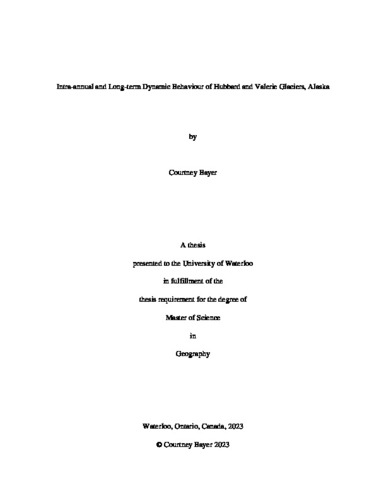| dc.description.abstract | Western North American mountain regions are warming at a faster rate than the global average, which is influencing the retreat and melting of glaciers, with a 75% disappearance of glacier volume in Western North America possible by 2100. The impacts of this are wide reaching, including increasing contributions to sea level rise, decreased freshwater availability, loss of stability of mountain slopes and changing aquatic ecosystems. Hubbard and Valerie glaciers are in the St. Elias Mountains of Alaska/Yukon, which is an important area of study as Alaskan glaciers are likely to respond to climate change differently than glaciers in other regions of the world. The studies on seasonal velocity flow of both glaciers have been limited, with few recent reports of dynamics and mass balance. The goals of this study were to 1) determine the seasonality of Hubbard and Valerie glaciers by creating the densest record of flow to date from July 2013-April 2022; 2) analyze the long-term velocity trend from 1985-2022 to confirm if both glaciers are decelerating; and 3) use surface elevation change and temperature data to analyze potential drivers of the determined velocity patterns. The velocity record of Hubbard and Valerie glaciers was created using ITS_LIVE, RADARSAT-2, RADARSAT Constellation Mission, and TerraSAR-X/TanDEM-X derived measurements. Valerie glacier had an expected seasonal pattern of peak velocities in May and minimum velocities between August-November. Hubbard Glacier had a seasonal pattern that had never been identified in previous studies, with peak velocities between December-February, velocities dropping slightly between January-April, a second velocity peak in May, and minimum velocities in August/September. The May peak and late summer minimum of both glaciers was determined to be from surface melt reaching the bed, increasing flow speeds with an inefficient drainage system before changing to a channelized subglacial hydrological system that causes a velocity drop. It is likely Hubbard Glacier’s winter velocity peak and slowdown before its May peak is internally driven, however the exact driver was not identified. The long-term velocity trend revealed Hubbard Glacier is decelerating, with a minimal deceleration near its terminus that was similar to the minimal deceleration on Valerie Glacier, while there was increased deceleration further up-glacier. For both glaciers, the deceleration did not match the expected patterns of thinning/thickening. Previous instances of pulsing were not resolved in this data. Overall, this study helps improve the knowledge of tidewater glacier dynamics through the identification of a unique intra-annual velocity pattern and can assist in improving sea level rise, ice dynamics, and mass loss models. | en |

